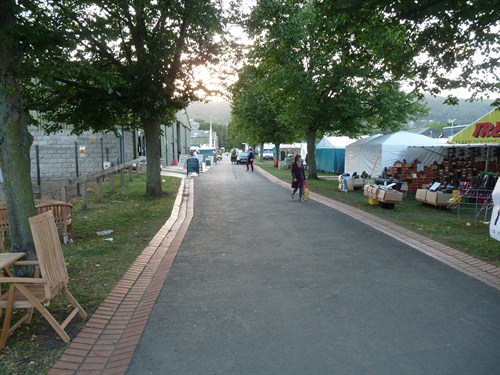The Turning Year
Thursday, October 4, 2012
Apologies for the late delivery of September news : operator
malfunction - don't ask!!
September turned out to be a more old fashioned form than recent
years with some sunny days, cold nights, heavy rain, occasional
strong winds and a few ground frosts. The asters were very late but
cosmos and rudbeckias continue to steal the colour show and
cabbages and sweetcorn are the current stars of the vegetable
garden.
Roses too have continued to flower almost continually.
and one of the best, a new acquisition this year, is a modern shrub
rose called "Jacqueline du Pre" a lovely tribute to a fine
musician
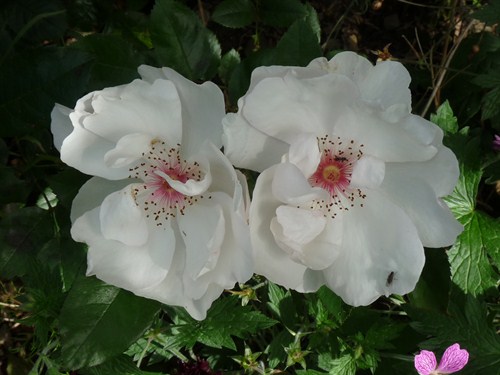
A very busy month with visitors to the gardens, the talks season
starting again, and a few days away visiting friends, nurseries and
gardens.
Additional weather report
Several days in the early part of the month temperatures peaked
at 21C, with a night time min of 2C on 22 September but no damage
done. Some torrential rain in the last week of the month
Garden update
The most significant feature has been the vibrancy of plants and
flowers in all corners of the gardens. Shrubs and trees have grown
significantly and all the moisture lovers continue to thrive
especially hydrangeas which are still pumping out new flowers when
normally they would be slowing down at this time of year.
A freshly opened flowerhead of hydrangea paniculata
"Phantom" taken at twilight. The paniculatas are reliable every
year because unlike the mopheads they flower on new
wood
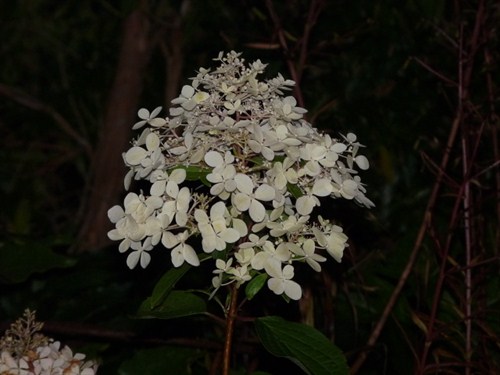
Vegetables continue to be plagued by rabbits (sorry to mention
them again but they are driving me nuts in spite of all my best
efforts with an electric fence and horticultural fleece). And
talking of nuts they recently invited their grey squirrel friends
to feast on the wonderful sweetcorn which was moister and sweeter
than I can remember - not that my memory is up to much these
days!!
Weeds and slugs as in all gardens are having a wonderful year
and have I mentioned bitter cress in previous news items? (There
you are, my memory again). It is well named as I feel very bitter
towards it. However many times I weed the borders and paths it
comes back and sets flowers within just 2 weeks. Fortunately it is
our only seriously invasive weed and thanks to a rigorous weeding
regime over many years we have largely eradicated most perennial
weeds from the gardens except for a little ground elder in a few
shady, moist locations.
The lawns continue to look wonderully green and lush as they
have done all "summer" but the weather is preventing scarifying and
aerating them which is an important early autumn job. Hope I can
get this done before the winter sets in.
There are some understated performers at this time of year whcih
thrive in some shade and moisture that never get a star billing.
Saxifraga fortuneii is one of these I have referred to before and
is just coming into flower with frothy heads of white or pink in a
variety of cultivars. Another is roscoea, a hardy member of the
ginger family, usually flowering from July onwards. It too comes in
a variety of forms and one I am particularly pleased with which has
been in flower for well over a month is a cross between r.
peacockii and R,rubra "Red Gurkha" with large purple flowers on
strong bronze coloured stems.
Roscoea peacockii x rubra
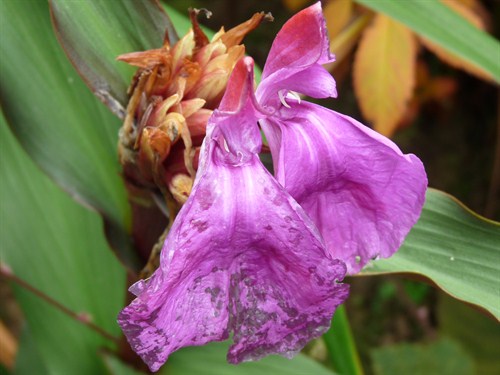
The trees and shrubs have only started to take on autumn colours
in the last week or so, much later than we have seen in the parts
of England we have visited during the month. I feel it could be a
vintage year for autumn colour provided there are no strong winds
in October - a vain hope but gardeners always cling to hope and
optimism!
In the nursery we have been looking to build up good stocks of
plants for next year's visitors (we already have a few bookings)
and to find new plants from nurseries and seed companies. As always
we will look to propogate as much as possible from some of the most
admired plants in the Gardens.
As an antidote to gardening (even I need a change sometimes!)
and in the drier interludes, I have started to saw up wood for the
winter from my large and much admired woodpile in the adjacent
field. I was fortunate enough to be able to take advantage of some
recently felled willow and ash which had become dangerous to
livestock and propery. It always amazes me how well ash will burn
even when fresh confirming once again the old rhyme that "Ash logs
green or ash logs brown are fit for a king with a golden crown" A
really good burning wood.
What's looking good?
The main flush of asters mostly comprising the imposing New York
form - nova belgii (mildew prone) and New England - nova angliae
(the midew free ones) has only just started, but they were
magnificient at Waterperry Gardens, Oxfordshire when we saw them a
couple of weeks ago.
An aster that has been in flower here since late July, is mildew
free and at just 18 inches or so tall with very stiff stems it
needs no staking is the star performer. It is called aster
frikartii "Monch", bulks up well over the years and is deservedly a
personal favourite and a popular aster.
The fabulous display of asters at Waterperry
Gardens
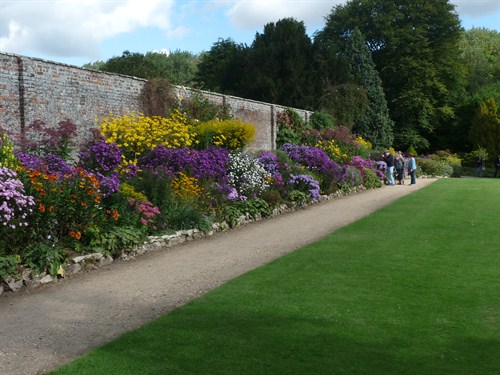
And the marvellous aster frifartii "Monch" in the
foreground, with possibly the best blue aster nova belgii "Marie
Ballard" in the centre picture.
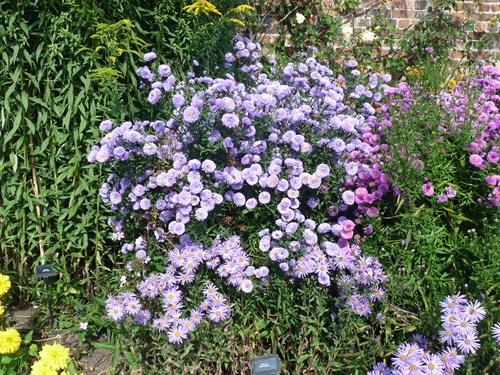
The colchicums, "autumn crocus" have come into flower, as they
always seem to overnight. Goblets of pink all over the gardens,
even in some moist shade, but all the recent rain and wind is
spoiling their show and causing them to collapse. They continue to
throw up new flowers over a number of weeks so I live in hope of a
very good late show. There are a good range of cultivars to choose
from, usually in shades of pink occasionally white, also including
I recently discovered, a yellow one. We saw a very nice species
form at Waterperry called C. aggripinum quite dwarf and more like a
true crocus in habit, with pink streaked purple flowers in an
impressive clump in a rock garden in sharp soil and in full sun -
another one on the shopping list!
Colchicum aggripinum
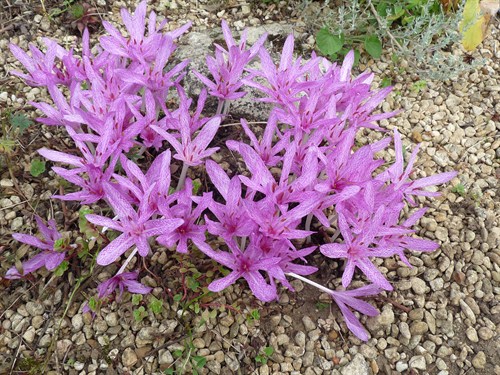
Tomatoes are still cropping very well in the large tunnel and
some are now on their 14th truss, being trained overy the roof of
the 9 foot tall tunnel. I wonder if we will be able to crop from
the uppermost trusses at Christmas as we did last year? - such a
treat in a dark time of year. "Rosada" a plum shaped small tomato
is proving to be a very reliable form with tender skins and the
best flavour of all and "Sungold" is also doing well with a very
sweet taste but it's only drawback is that the skins tend to split
easily on the plant. Moira has been making soup for Wales from the
total of 30 plants we have in the tunnel!
Peppers are very slow ripening although there are already a good
number of ripe fruits on the chilli peppers (only a mild form you
Scoville Heat Scale nuts will be disappointed to learn). I am a
whimp when it comes to heat so no "Scotch Bonnets" here!
Wildlife and countryside
The surest sign of the arrival of autumn is the turning of the
leaves which began in the last week of the month with the native
wild cherries. Acers in the garden are already turning red after a
few cold nights and the sorbus "Olympic Flame" is well named for
its vivid burnt orange colours.
The swallows have been massing on the wires in the last couple
of days, many having raised a second brood in spite of the adverse
weather conditions. House martins have been far less in evidence
with just the odd birds sighted and for once, none have attempted
to nest on the north facing wall of the Lodge.
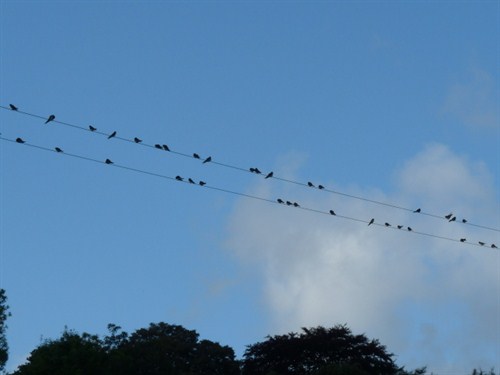
There are abundant blackberries but no hazel nuts which were in
short supply anyway and the few that remained were plundered
by squirrels long before they were ripe (when they haven't been
eating the sweeetcorn).
The dragonflies and butterflies are gone but a few cabbage white
caterpillars survived on the brassicas until I caught up with
them!
On colder evenings there is a real call of the wild in the
valley with foxes calling to each other at the start of the mating
season, their high pitched screams piercing the night
air.
Visits
Visitors to the gardens continued until mid month and in just 4
weeks of opening for the National Gardens Scheme we raised £816 for
the charities supported by the NGS. A big thank you to all those
who visited us. Next year we will be opening for By Appointment
visits from June to September and already have a number of dates
booked including two from The Dutch RHS and one from the Dorset
Group of The Hardy Plant Society. To arrange a visit in 2013 please
get in touch with us. Please note that we will not be having any
more Open Days.
The garden talks season has started well, not surprisingly
"Autumn Colour" being the most requested talk of the four we
delivered in September. There are 5 more in October before we go to
North Wales for Medwyn Williams Vegetable Masterclass weekend in
November.
We have had some visits of our own to gardens and nurseries far
and wide, including Hidcote, Waterperry Gardens in Oxfordshire and
Oxford University Botanic Gardens. Malvern Autumn Show was also a
not to be missed outing with wonderful displays of produce in the
Harvest Pavilion, a tribute to the persistence and skill of the
many exhibitors. The Pavilion is the essential heart of the show
for me and perfectly captures the mood and spirit of September.
Alongside the vegetable competitions are displays by numerous plant
societes and those by the British Streptocarpus Society took some
beating.
A simply stunning plant grown from seed crossed by a
member and subsequently named. Quite unique and a shame I
wasn't there on Sunday as it was for sale at the end of the
Show!
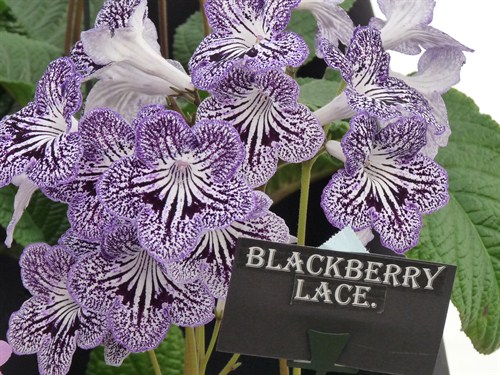
And a footnote to the Malvern Autumn Show. Medwyn won another
Gold Medal for his magnificient display of vegetables - it was
difficult to believe it has been a very difficult year or that he
was concerned about the quality of his leeks!
The entrance to Hidcote. Lawrence Johnston is often
fittingly referred to as "the quiet American" but had a major
influence on garden design in the first half of the 20th
Century.

The famous Red Border at Hidcote but sadly not
much red in evidence - somewhat disappointing.
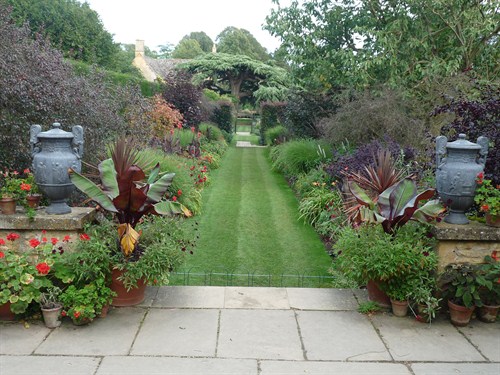
This lovely "theatre" at the entrance to Waterperry
Gardens with a display of cut asters.

The entrance to Oxford University Botanic Gardens. What
a backdrop!!
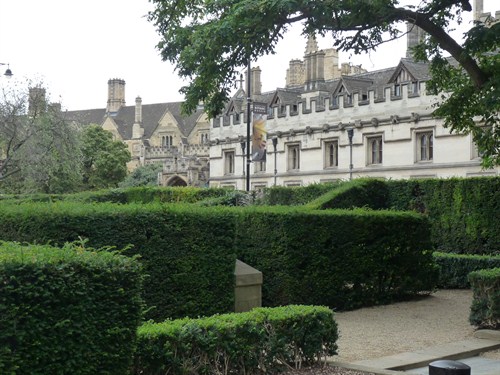
The Botanic Gardens have several glasshouses exhibiting
plants from different climate zones and with the Amazonian
Waterlily "Victoriae" and tropical waterlilies it is quite clear
which one this is.

An imaginative display of vegetables at Malvern was
worthy of its first prize in this class.
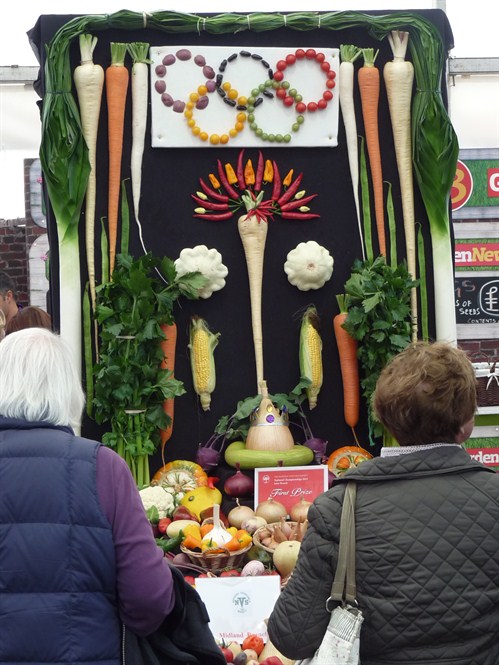
A view of the showground visitors rarely see, taken
after closing time when all the crowds had gone home.
